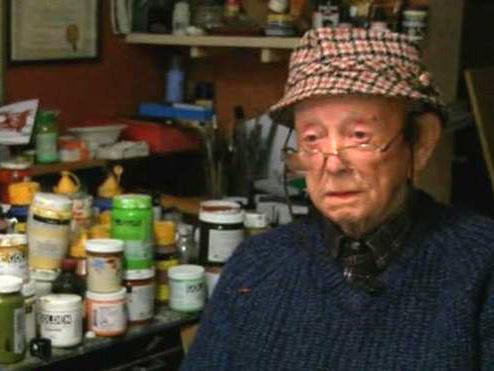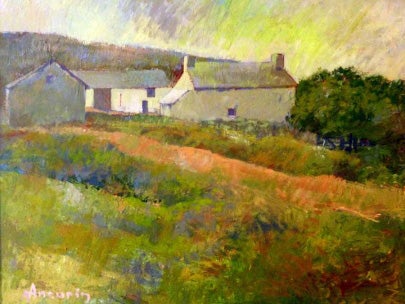Aneurin Jones: Painter who found inspiration in the people of upland mid-Wales
Aneurin, as he was known throughout Wales, chronicled the timeless landscapes of Welsh backcountry in Breconshire, Carmarthenshire and Cardiganshire

If Kyffin Williams was the painter par excellence of the mountains of North Wales, Aneurin Jones took as his subject-matter the people of mid-Wales: a landscape perhaps less spectacular but no less rugged, and in some respects just as harsh. He painted the farmers of upland Powys, their hardy womenfolk, their livestock and, in particular, their horses – for which he had special affection. In so doing, he recorded a rural society that depended on agriculture and the small family farm, and felt himself to be the chronicler of a way of life that was fast disappearing.
There is a timelesseness about his studies of the chapel, the sheep-dog trial, the ploughing match, the byre, sheep shearing, the tug o’war, washing day, baking, the harvest supper, the game of draughts, the choir, the public house – all the multifarious activities of a largely self-sufficient community that had remained more or less unchanged for hundreds of years.
Although specifically located in the back-country of Breconshire, Carmarthenshire and Cardiganshire, there is a sense of universality about his work, as if he were painting country folk anywhere in western Europe: a people bent to their daily labours or enjoying rare pleasures, but always yoked to the soil, growing almost organically from the fields and hills that gave them sustenance.
The enormous appeal of his pictures, and his canny policy of keeping his prices within reach of those who do not usually buy contemporary art, made his work extremely popular in Wales, especially as he was the product of the Welsh-speaking society he depicted and had, as a consequence, an authenticity that is not always to be found among those who have taken Wales and the Welsh as their theme. His strength doubtless lay in the fact that he painted people who, despite their universality, were clearly drawn from life, so that it was possible to put names to many who sat for him – and sometimes to their dogs and horses too.
Jones knew his subject matter through and through, never tiring of walking the lanes and bridle paths that took him to some of the most remote places in southern Britain: a vast tract of land which the poet Harri Webb called ‘the Green Desert’, and which, despite depopulation, retained for him a magical quality which he captured in his work. He was never happier than when drawing a man with a scythe cutting grass on a steep slope or a shepherd handling his border collie, observed so vividly that it is almost possible to hear the dog panting and smell the breath from its muzzle.
He was a countryman by birth and upbringing. Born at a small homestead in Cwm Wysg, near Trecastle, on the border of Breconshire and Carmarthenshire (a district treated by the novelist Richard Vaughan in his Van trilogy of which 1951’s Moulded in Earth is the best known), he was familiar not only with the topography of his native patch but also with its history. Not far from his home lay Llyn-y-fan Fach, a lake near Llanddeusant high in the Black Mountains, with its legend of faery cattle thought to date back through folk memory to the Iron Age.

From the more recent past, there were stories of ghostly riders on white horses, chapel preachers, ruined farms, fairs, agricultural shows, ploughing matches, village characters, and Twm Shon Catti, the Welsh Robin Hood, all of which found a place in his paintings, giving them a texture and depth that added to their appeal. Some of his paintings, especially of the trotting Welsh cob and the magnificent shire horse, prompted poets to write verse which appeared in his book, Aneurin (2000).
There was, too, the memory of the War Office commandeering the Epynt to make a firing range, which displaced people and destroyed their homes. The ghosts of that unhappy episode from the Second World War still trouble the hills of northern Breconshire. Jones’s group of Epynt farmers (1978), in their caps and rough coats, stand idly and awkwardly as if at a graveside, and in the background is the bare landscape from which they have been evicted.
It was the people – his people – that Jones never tired of celebrating. The men and women who appear in his paintings are heroic figures, gnarled by the elements, surviving because of their innate strength and tenacity. There is a Titanic quality to many of his labourers, who are caught up in a struggle with a grudging soil and the wind and rain which threaten to strip them of their humanity, in much the same way as R S Thomas had to insist that his dung-gaitered peasant, Iago Prytherch, was also a man.
On the other hand, in his domestic scenes there is a gentler touch, like the pictures of a farm wife feeding her chickens, brushing the floor of her kitchen or hanging out the washing in the yard, all painted about 1983. There is a sincerity and lack of pretension in these lyrical studies, which some prefer to the more muscular, heavy-booted men whose large hands grasp their sticks and spades with primeval strength and to whom he returned again and again.
If there is something absent in Jones’s canvases, it is an awareness of time passing: of changes in country life, of the old order passing and giving place to the new. There are no tractors, combine harvesters, television aerials or motor cars in his pictures, and the people are dressed in the earth-coloured clothes of pre-war days.
Towards the end of his career the boldly painted figures gave way to a soft, misty depiction of middle-aged people in passive poses, which suggested that they were waiting for the inevitable end of their way of life. It is as if time, for him, had stopped in the 1950s, when he left home for Art College in Swansea. This was a break with his native place from which he never fully recovered, and it is possible to see his work as nostalgia: an elegiac lament for what was lost when he left Cwm Wysg.
In Swansea he found he had a special affinity with stained glass. Designing church windows at the Celtic Studios for two years, he learned the elements of draughtsmanship which make his pictures so technically pleasing. Although from 1958 to 1986 he earned a living as an art teacher at Ysgol y Preseli (the Comprehensive School in Crymych, Pembrokeshire) where he had the support of an artistically minded headmaster James Nicholas, he was not a weekend painter and there is nothing amateur about his work. In the Preseli hill-country, land of the Mabinogion tales, he found something of the magic he had once known in Cwm Wysg.
He was not averse to making overtly political statements. One of his most celebrated canvases is the one showing the slogan “Cofiwch Dryweryn” (“Remember Tryweryn”,1982) painted on a crumbling barn wall a few miles south of Aberystwyth: a reference to the drowning of the Tryweryn valley to make a reservoir for Liverpool Corporation.
In 1994, he painted a large mural for the church at Pennal near Machynlleth, which showed Owain Glyndwr raising the standard of rebellion against the English king and proclaiming Welsh independence. He believed, as a people’s remembrancer, that he had a duty to encourage his compatriots to resist the erosion of the Welsh-speaking districts of West and North Wales in the face of English in-migration.
Aneurin – he was known throughout Wales by his first name only – was a small, wiry man, as tough as the hill stock from which he had sprung, with a low chuckle and sparkling eyes, and he enjoyed nothing better than a session of storytelling or a pint in congenial company. He was a regular visitor to the National Eisteddfod every August, and could often be found in the Arts and Crafts Pavilion where he enjoyed the regard of his many admirers.
A celebratory book about his work was published as Byd Aneurin (Aneurin’s World) in 2007.
Aneurin Morgan Jones, teacher and painter, born 1930, died 25 September 2017
Join our commenting forum
Join thought-provoking conversations, follow other Independent readers and see their replies
Comments